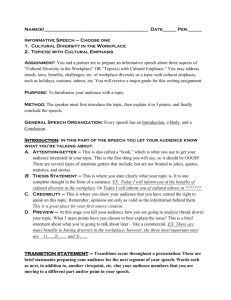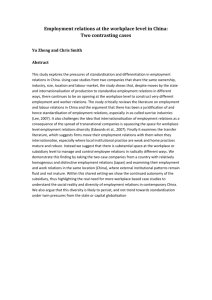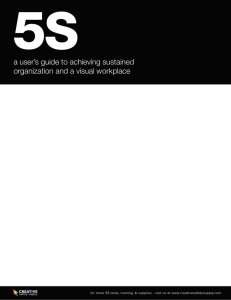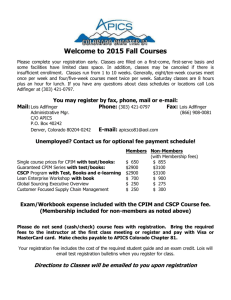The Visual Workplace - Competitiveamerica.us
advertisement
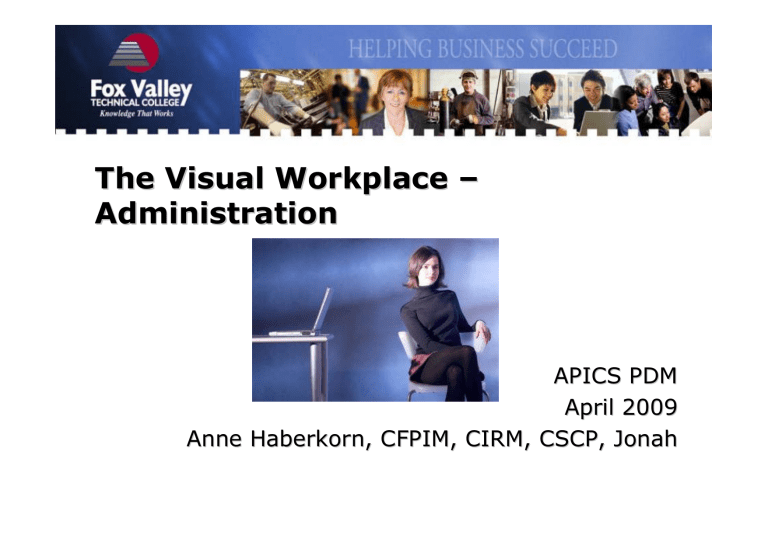
The Visual Workplace – Administration APICS PDM April 2009 Anne Haberkorn, CFPIM, CIRM, CSCP, Jonah Why Visual Administration? Information Changes Good People, Not aligned Good People, Aligned Visual Management “The control of authorized levels of activities and inventories in a way that is instantly and visibly obvious. This type of activity and inventory control is used in a workplace organization where everything has an assigned place and is in its place. .” --APICS Dictionary 6 Factory Fact • Up to 75% of all activities in the typical manufacturing organization are non-value-added. Service Fact • Cost of services are inflated by a minimum of 30% due to wasteful practices. Some service costs are inflated by 60%! Workplace Organization - 5S A safe, clean, neat arrangement of the workplace which provides a specific location for everything, and eliminates anything not required. Elements of a 5S Program 1. 2. 3. 4. 5. 6. Sort Set In Order Shine Standardize Sustain Safety? Getting Started • Cross-functional team • Team charter • Workplace Scan Display “Before” Pictures • Visual report • Encourages interaction with area employees 13 14 16 Sort • • • • Sort through items in the area Keep what is needed Eliminate what is not needed Reduce the number of items to the quantity required at any given time What problems occur in your work area because of the accumulation of unneeded items? Red Tag Unnecessary Items • • • • Identify unneeded, misplace items Attach Red Tags Move to holding area Dispose of truly unneeded items Red Tagging Criteria • • • • • Does it have a function in this area? Is it needed? By whom? How often is it needed? If we remove it, will it really matter? Is it in the way? Does it take too much space? • Can you standardize by using the same product to meet different needs? Administrative Opportunities? • Paper files • Computer files • Office supplies • Records retention Set In Order Wastes to avoid: • • • • • Excess Motion Searching Human Energy Waiting Unsafe Conditions Set In Order Procedure • • • • • Identify best locations Relocate items Set height and size limits Focus on safety / ergonomics Use visual controls 22 Visual Controls • Simple signals that guide our actions 23 Visual Displays • Simple exhibits that provide information Display Guidelines • • • • • Be able to read from 3-5 feet away Keep the information current Meet the 5 minute rule Use color coding Seek everyone’s input Visual Controls/Displays? Shine • Clean everything inside and out • Inspect through cleaning • Prevent dirt, grime, and contamination from occurring • Archive computer files, and paper files 27 Sources of Contamination in Administrative functions: • • • • • • Debris Documents Extra Tools Stacks of paper Old files Out-of-date brochures • Dirt and dust • Food and drink • Poor work habits • Materials left by other people 28 Shine Procedure • Determine targets and assignments • Determine cleaning methods • Get the right tools and supplies • Automate if ready 29 Standardize • • • • • Uniform standards Easy to use Create and use checklists Establish a simple action plan Keep necessary information near the process • Make everything visual 30 Color coding A Change in Thinking • 30 second rule Every piece of information in 30 seconds. 32 Sustain • Correct procedures have become a habit • Proper training of all workers has occurred • “Buy-in” from workers and a change in work • Habits have been achieved • The workplace is well-ordered and run by agreed upon standards • Waste walks 33 Common Issues Visual signals established Involvement and enthusiasm Supplier relationship management Utilize team ideas Alignment of human resources Leverage creativity 36 Learning to See “It's not what you look at that matters, it's what you see” -Henry David Thoreau The Visual Workplace – Administration APICS PDM April 2009 Anne Haberkorn, CFPIM, CIRM, CSCP, Jonah 39





